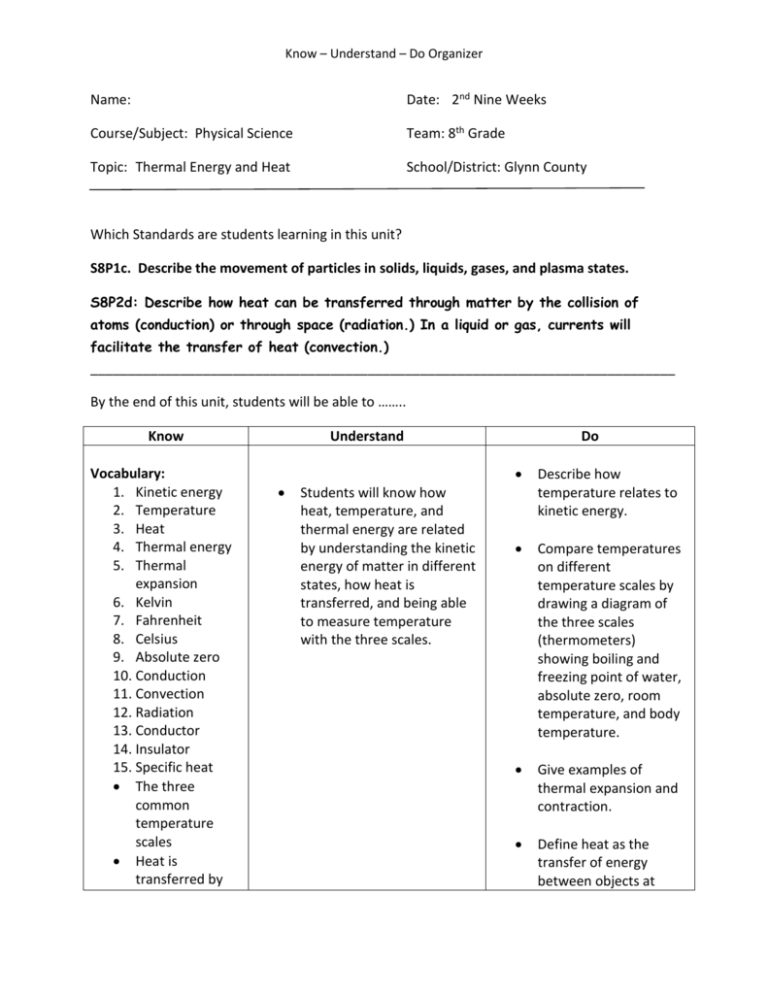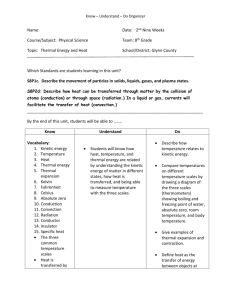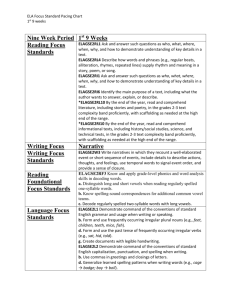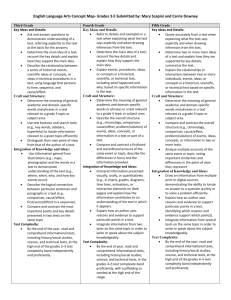Know – Understand – Do Organizer Name: Date: 2nd Nine Weeks
advertisement

Know – Understand – Do Organizer Name: Date: 2nd Nine Weeks Course/Subject: Physical Science Team: 8th Grade Topic: Thermal Energy and Heat School/District: Glynn County Which Standards are students learning in this unit? S8P1c. Describe the movement of particles in solids, liquids, gases, and plasma states. S8P2d: Describe how heat can be transferred through matter by the collision of atoms (conduction) or through space (radiation.) In a liquid or gas, currents will facilitate the transfer of heat (convection.) ______________________________________________________________________________ By the end of this unit, students will be able to …….. Know Vocabulary: 1. Kinetic energy 2. Temperature 3. Heat 4. Thermal energy 5. Thermal expansion 6. Kelvin 7. Fahrenheit 8. Celsius 9. Absolute zero 10. Conduction 11. Convection 12. Radiation 13. Conductor 14. Insulator 15. Specific heat The three common temperature scales Heat is transferred by Understand Students will know how heat, temperature, and thermal energy are related by understanding the kinetic energy of matter in different states, how heat is transferred, and being able to measure temperature with the three scales. Do Describe how temperature relates to kinetic energy. Compare temperatures on different temperature scales by drawing a diagram of the three scales (thermometers) showing boiling and freezing point of water, absolute zero, room temperature, and body temperature. Give examples of thermal expansion and contraction. Define heat as the transfer of energy between objects at Know – Understand – Do Organizer three ways. different temperatures Direction in which heat moves. Compare and contrast conduction, convection, and radiation in a written essay. Differentiate between heat, temperature, and thermal energy. Create a foldable that diagrams heat transfer, temperature, and kinetic energy/motion of solids, liquids, and gases Compare and contrast temperature, thermal energy, and heat on a triple Venn Diagram. Read and follow lab procedures. (L6-8RST3) Write Lab Report for each lab on waves. (L6-WHST2d, e,f) Compare and contrast information learned from text and video format. (L6-WHST4) (L6-WHST1b,) Assessment: Summative Unit Test- multiple format Vocabulary Quizzes Graded Foldable Essay- conduction, convection, radiation Graded Venn Know – Understand – Do Organizer 8th grade COMMON CORE Reading, Writing and Content Correlation Activity Vocabulary Acquisition Reading Standard L6-8RST4: Determine the meaning of symbols, key terms, and other domainspecific words and phrases as they are used in a specific scientific or technical context relevant to grades 6–8 texts and topics. Writing Standard L6-8WHST4: Produce clear and coherent writing in which the development, organization, and style are appropriate to task, purpose, and audience. L6-8RST10: By the end of grade 8, read and comprehend science/technical texts in the grades 6–8 text complexity band independently and proficiently. L6-8RST9: Compare and contrast the information gained from experiments, simulations, video or multimedia sources with that gained from reading a text on the same topic. Labs: following instructions and writing lab reports L6-8RST3: Follow precisely a multistep procedure when carrying out experiments, taking measurements, or performing technical tasks. L6-8RST10: By the end of grade 8, read and comprehend science/technical texts in the grades 6–8 text complexity band L6-8WHST2: Write informative/explanatory texts, including the narration of historical events, scientific procedures/ experiments, or technical processes. a. Introduce a topic clearly, previewing what is to follow; organize ideas, concepts, and information into broader categories as appropriate to achieving purpose; include formatting (e.g., headings), graphics (e.g., charts, tables), and multimedia when useful to aiding comprehension. d. Use precise language and domain-specific vocabulary to inform about or explain the topic. e. Establish and maintain a formal style and Know – Understand – Do Organizer independently and proficiently. objective tone. f. Provide a concluding statement or section that follows from and supports the information or explanation presented. L6-8WHST4: Produce clear and coherent writing in which the development, organization, and style are appropriate to task, purpose, and audience. L6-8WHST5: With some guidance and support from peers and adults, develop and strengthen writing as needed by planning, revising, editing, rewriting, or trying a new approach, focusing on how well purpose and audience have been addressed. Answering Essential and Key Questions, Summarizers using notes, text and student learning maps L6-8RST1: Cite specific textual evidence to support analysis of science and technical texts. L6-8RST2: Determine the central ideas or conclusions of a text; provide an accurate summary of the text distinct from prior knowledge or opinions. L6-8RST7: Integrate quantitative or technical information expressed in words in a text with a version of that information expressed visually (e.g., in a flowchart, diagram, model, graph, or table). L6-8RST10: By the end of grade 8, read and comprehend science/technical texts in L6-8WHST10: Write routinely over extended time frames (time for reflection and revision) and shorter time frames (a single sitting or a day or two) for a range of discipline-specific tasks, purposes, and audiences. L6-8WHST1: Write arguments focused on discipline-specific content b. Support claim(s) with logical reasoning and relevant, accurate data and evidence that demonstrate an understanding of the topic or text, using credible sources. c. Use words, phrases, and clauses to create cohesion and clarify the relationships among claim(s), counterclaims, reasons, and evidence. d. Establish and maintain a formal style. e. Provide a concluding statement or section that follows from and supports the argument presented. L6-8WHST4: Produce clear and coherent writing in which the development, organization, and style are appropriate to task, purpose, and audience. L6-8WHST5: With some guidance and support from peers and adults, develop and strengthen Know – Understand – Do Organizer the grades 6–8 text complexity band independently and proficiently. Videos and L6-8RST9: Compare and Demonstrations contrast the information gained from experiments, simulations, video or multimedia sources with that gained from reading a text on the same topic. L6-8RST4: Determine the meaning of symbols, key terms, and other domainspecific words and phrases as they are used in a specific scientific or technical context relevant to grades 6–8 texts and topics. writing as needed by planning, revising, editing, rewriting, or trying a new approach, focusing on how well purpose and audience have been addressed. L6-8WHST1: Write arguments focused on discipline-specific content. a. Introduce claim(s) about a topic or issue, acknowledge and distinguish the claim(s) from alternate or opposing claims, and organize the reasons and evidence logically.










